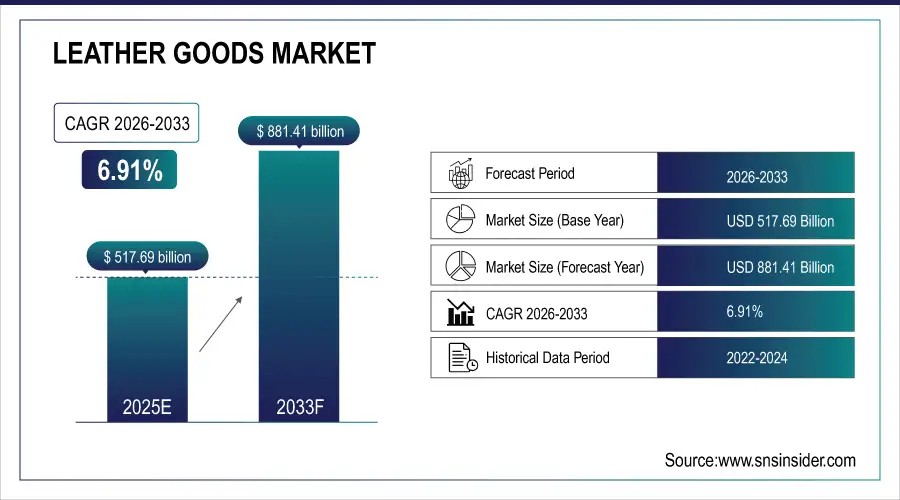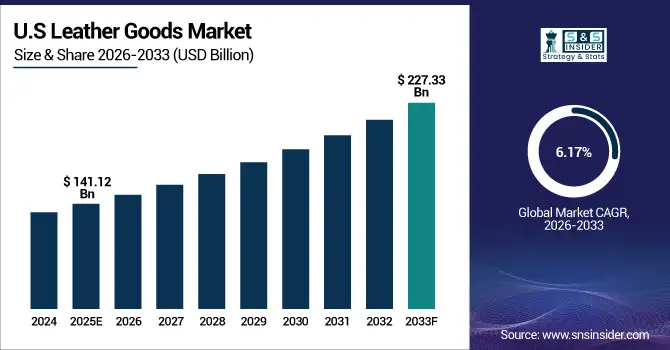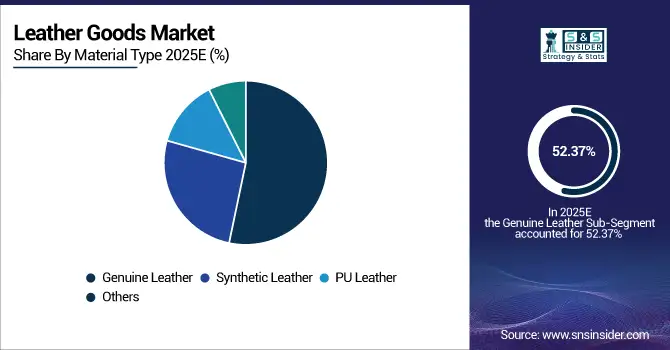Leather Goods Market Report Scope & Overview:
The Leather Goods Market Size was valued at USD 517.69 Billion in 2025E and is projected to reach USD 881.41 Billion by 2033, growing at a CAGR of 6.91% during the forecast period 2026–2033.
The Leather Goods Market analysis report for growth provides details of the market by new technologies, stakeholders, competitors, and other contributors. Increasing consumer inclination toward premium, ethical and designer leather coupled with growing usage in fashion, accessories, and automotive are expected to foster market growth.
Leather Goods production reached 3.2 billion units in 2025, driven by rising demand for premium and sustainable handbags, footwear, and accessories.
Market Size and Forecast:
-
Market Size in 2025: USD 517.69 Billion
-
Market Size by 2033: USD 881.41 Billion
-
CAGR: 6.91% from 2026 to 2033
-
Base Year: 2025
-
Forecast Period: 2026–2033
-
Historical Data: 2022–2024

To Get more information on Leather Goods Market - Request Free Sample Report
Leather Goods Market Trends:
-
Increasing consumer preference toward premium, sustainable and designer leather products is driving demand in handbags, footwear, belts and accessories.
-
The fashion culture, influencer-led trends and celebrity endorsements have fuelled the demand for exclusive and limited-edition leather collections.
-
Growing penetration of e-commerce players and modern retailers is aiding product distribution in urban and Tier-2/3 cities.
-
Artisanal and sustainable practices are coming into play as consumers continue to seek eco-friendly and ethically-sourced leather-alternative options.
-
Market dynamics trend toward premiumization, distinct brand identity and the personalisation of leather in response to changing lifestyles and fashion.
U.S. Leather Goods Market Insights:
The U.S. Leather Goods Market is projected to grow from USD 141.12 Billion in 2025E to USD 227.33 Billion by 2033, at a CAGR of 6.17%. Growth is supported by mounting sales of premium and sustainable leather items, durable fashion retail networks and the growing adoption by online businesses and luxury brands.

Leather Goods Market Growth Drivers:
-
Rising demand for premium and sustainable leather products, fueled by fashion trends and ethical consumer choices.
Rising demand for premium and sustainable leather products is a key driver of Leather Goods Market Growth. Consumers are now more inclined toward high-quality, ethically produced and designer leather through handbags, footwear, belts or accessories. The increased adoption is underpinned by a broader inroad into fashion, lifestyle and automotive applications and greater penetration through e-commerce and modern retail. Skilled workmanship, environment friendly production and new design ideas are factors that differentiate products, quality perception and longer market extension.
Premium and sustainable leather product sales grew 8.2% in 2025, driven by rising consumer preference and expanding fashion and lifestyle applications.
Leather Goods Market Restraints:
-
High raw material costs, limited availability of quality leather, and complex manufacturing processes are restricting market expansion.
High raw material costs, limited availability of quality leather, and complex manufacturing processes are key restraints for the Leather Goods Market. Quality checks are very strict, and the supply chain is long when purchasing of high end or ethically produced leather; this also makes production efficiency limited. Higher costs from material and craftsmanship have made pricing, respectively, less practical in a number of markets. Furthermore, ecofriendly production methods and specific designs which are desirable inhibit mass production and uphold a competitive equilibrium between competing brands.
Leather Goods Market Opportunities:
-
Increasing consumer interest in sustainable, designer, personalized leather creates opportunities for innovative collections and brand differentiation.
Increasing consumer interest in sustainable, designer, and personalized leather presents a strong opportunity for market growth. Customers are looking for high-quality, one-of-a-kind and ethically made items, so brands are working to ramp up their material offerings, craftsmanship quality and package design. Sustainable sourcing and production that is eco-friendly becomes better appreciated in light of environmental and ethical fashion trends. This emphasis of premiumization, personalization and sustainability enable the product differentiation, brand value addition and long-term growth in Leather Goods Market.
Sustainable and designer leather accounted for 24% of leather goods innovations in 2025, driven by rising demand for premium, personalized products.
Leather Goods Market Segmentation Analysis:
-
By Product Type, Bags held the largest market share of 38.42% in 2025, while Footwear is expected to grow at the fastest CAGR of 7.18% during 2026–2033.
-
By Material Type, Genuine Leather dominated with a 52.37% share in 2025, while PU Leather is projected to expand at the fastest CAGR of 8.05%.
-
By Distribution Channel, Offline/Retail accounted for the highest market share of 45.63% in 2025, and Online sales are expected to record the fastest CAGR of 9.12%.
-
By End-Use Industry, Fashion & Apparel held the largest share of 48.29% in 2025, while Automotive is expected to grow at the fastest CAGR of 6.87% during the forecast period.
By Material Type, Genuine Leather Dominates While PU Leather Expands Rapidly:
Genuine Leather segment dominated the market due to its durability, luxurious feel and its premium status for the consumer. It is in many bags, belts, shoes and accessories ruling the roost. PU Leather is the fastest growing segment due to ethical sourcing, low price and trend of sustainable products. Pioneering production techniques and growing knowledge amongst environmentally friendly customers are speeding up the inclusion of be panthenols across applications, which is expected to lead to continued market growth and greater diversification.

By Product Type, Bags Dominate While Footwear Expands Rapidly:
Bags segment dominated the market with wide-ranging appeal and daily use combined with heavy brand presence both online and offline. With the choice of one, two and three tone colors these free-weight bars are sure to please. Footwear is the fastest-growing segment, driven by increasing demand for designer and sustainable shoes. However, its rapid growth is driven by young consumer demand and creative, high-end designs which are contributing to lifting the overall leather goods market.
By Distribution Channel, Offline/Retail Dominates While Online Expands Rapidly:
Offline/Retail segment dominated the market, being supported with a brick-and-mortar presence, people branding and opportunity for its customers to shop in person. Consumers desire to touch and feel leather products in stores and keep leadership. Online is the fastest growing segment, rising with new e-commerce led convenience and greater penetration in urban and semi-urban regions. Digital advertising, influencer-driven marketing, and virtual showcases accelerate adoption and expansion into market.
By End-Use Industry, Fashion & Apparel Dominates While Automotive Expands Rapidly:
Fashion & Apparel segment dominated the market due to the significant demand for handbags, belts, footwear and accessories. Seasonal volume trends, brand activations and premiumization underline it leadership. Automotive is the fastest growing segment as a result of increasing use of leather in car interiors and increase in demand for luxury cars. Customization, sustainable materials and high-end aesthetic is driving fast acceptance for long term growth in lifestyle and automotive segments.
Leather Goods Market Regional Analysis:
North America Leather Goods Market Insights:
North America dominates the Leather Goods Market, holding a 34.76% share in 2025, owing to increase in demand for high-quality, designer and sustainable products. Rising consumption on fashion and accessories and brand fashionable status seeking help growth keep a steady pace. The development of e-commerce, customization trend and environment friendly material also increase the penetration degree. This pursuit of quality workmanship and luxury appeal advances the lead position of the region in leather goods.

Get Customized Report as per Your Business Requirement - Enquiry Now
U.S. Leather Goods Market Insights:
The U.S. Leather Goods Market is driven by rising consumer preference for premium, designer, and sustainable leather products across fashion, accessories, and footwear. Growth is supported by expanding e-commerce and retail networks, increasing disposable income, demand for personalized and ethical products, and innovative designs, all enhancing market penetration and long-term expansion.
Asia-Pacific Leather Goods Market Insights:
Asia-Pacific is the fastest-growing region in the Leather Goods Market, with a CAGR of 8.94% during 2026–2033. Furthermore, leading countries such as China, India, Japan and Australia have a growing demand for designer premium leather products especially when the urbanization is increasing which resulted in higher disposable income. Continuing fashion, lifestyle and automotive applications with the growth of e-commerce and new retail distribution means that products are more available even as fast regional market penetration occurs.
China Leather Goods Market Insights:
The China Leather Goods Market is also supported by increasing disposable income, urban population and retail and e-commerce industry. The increasing consumer inclination toward premium, sustainable, and design-specific leather articles also promotes availability and uptake. These trends mean that China is becoming one of the most important players in the rapidly expanding leather goods market in Asia-Pacific.
Europe Leather Goods Market Insights:
Europe Leather Goods Market is growing with a decent growth rate as spurt in the market is attributed to rise in penchant among people for fashion wear and trickle-down trend of latest designs from prominent designers. Focus markets are Germany, UK, France and Italy. The growth is driven by wider retail presence, penetration of ecommerce and growing demand for handmade, customized high quality leather products. Design and innovation, craftmanship and sustainability are enhancing the region's market exposure and sustainable growth.
Germany Leather Goods Market Insights:
Germany is an important region for leather goods, and there's equal interest in fashion, accessories and footwear. Increasing consumer inclination toward premium and designer leather and sustainably-produced products fuels the growth. Quality craftsmanship, creativity and responsible sourcing contribute to brand identity and market authority driving long-term growth in retail and e-commerce.
Latin America Leather Goods Market Insights:
The Latin America Leather Goods Market is developing on the back of increasing popularity of premium, designer, and green leathers. Increasing retail and e-commerce, rising disposable incomes and urbanization drive growth. Craft and crafty Core market development is being driven by innovation with a focus on the craftsmanship of artists, and ethical sourcing and local production in main markets such as Brazil, Mexico or Argentina.
Middle East and Africa Leather Goods Market Insights:
The Middle East & Africa Leather Goods Market is projected to accelerate owing to increase in disposable income, proliferation of retail and online distribution network along with surge in demand for premium, designer and sustainable leather goods. Luxury fashion trends, brand strategies and evolving consumer lifestyle trends are fuelling market growth in leading countries of this region.
Leather Goods Market Competitive Landscape:
Hermès International S.A., headquartered in France, is one of the world’s leading luxury leather goods manufacturers, renowned for its iconic handbags, belts, and accessories. The firm leads the sector due to their heritage craft, quality materials and exclusivity the company dominates on both its product and business. Hermès’s limited production, classic styles and network of stores help keep it premium priced. Its premium image, focus on quality and reputation for innovation will continue to drive demand and leadership in the market.
-
In March 2025, Hermès launched the Wool Birkin 25, combining wool and leather to showcase craftsmanship and innovation. This product caters to sustainable luxury demand, offering timeless elegance and appealing to eco-conscious consumers seeking exclusive, high-quality accessories.
Louis Vuitton, headquartered in France, is a premier luxury leather goods brand, famous for handbags, luggage, and accessories. It commands the market by virtue of brand legacy, an exhaustive international retail network and unparalleled expertise. By fusing traditional with contemporary styles, the company designs products that are sought-after and aspirational. Strategic marketing, partnerships and continuous maintaining up of product excellence or the other help to drive a loyalist consumer for the brand louis Vuitton making it to dominate in its market for competitive luxury leather formed sector.
-
In August 2025, Louis Vuitton introduced La Beauté Louis Vuitton, a makeup collection with lipsticks, lip balms, and eyeshadows. The launch expands the brand’s portfolio, attracts younger consumers, and reinforces its position as a luxury lifestyle brand beyond traditional leather goods.
Gucci, headquartered in Italy, is a top-tier luxury leather goods company known for handbags, footwear, and premium accessories. It excels by virtue of history, signature designs, and innovation combined with fashion trends. Gucci’s high-quality craftsmanship, store network and brand positioning draw in wealthy consumers. Sustained marketing, testimonials and special edition lines contribute to brand desirability satisfaction so that it stands firm at the top of the market of luxury leather goods.
-
In September 2025, Gucci unveiled the Giglio tote bag during its Cruise 2026 show, inspired by archival designs. This launch blends heritage craftsmanship with contemporary style, appealing to consumers seeking functional yet elegant luxury accessories, strengthening Gucci’s leather goods presence.
Leather Goods Market Key Players:
Some of the Leather Goods Market Companies are:
-
Hermès International S.A.
-
Louis Vuitton Malletier SAS
-
Guccio Gucci S.p.A.
-
Prada S.p.A.
-
Chanel S.A.
-
Burberry Group plc
-
Tapestry, Inc.
-
Capri Holdings Limited
-
Fossil Group, Inc.
-
Richemont Group
-
Michael Kors
-
Coach
-
Bvlgari
-
Tod’s S.p.A.
-
Salvatore Ferragamo S.p.A.
-
Mulberry Group plc
-
Longchamp
-
Kate Spade
-
Radley London
-
Smythson
| Report Attributes | Details |
|---|---|
| Market Size in 2025E | USD 517.69 Billion |
| Market Size by 2033 | USD 881.41 Billion |
| CAGR | CAGR of 6.91% From 2026 to 2033 |
| Base Year | 2025E |
| Forecast Period | 2026-2033 |
| Historical Data | 2022-2024 |
| Report Scope & Coverage | Market Size, Segments Analysis, Competitive Landscape, Regional Analysis, DROC & SWOT Analysis, Forecast Outlook |
| Key Segments | • By Product Type (Bags, Footwear, Belts, Wallets, Apparel, Others) • By Material Type (Genuine Leather, Synthetic Leather, PU Leather, Others) • By Distribution Channel (Online, Offline/Retail, Specialty Stores, Others) • By End-Use Industry (Fashion & Apparel, Automotive, Furniture, Accessories, Others) |
| Regional Analysis/Coverage | North America (US, Canada), Europe (Germany, UK, France, Italy, Spain, Russia, Poland, Rest of Europe), Asia Pacific (China, India, Japan, South Korea, Australia, ASEAN Countries, Rest of Asia Pacific), Middle East & Africa (UAE, Saudi Arabia, Qatar, South Africa, Rest of Middle East & Africa), Latin America (Brazil, Argentina, Mexico, Colombia, Rest of Latin America). |
| Company Profiles | Hermès International S.A., Louis Vuitton Malletier SAS, Guccio Gucci S.p.A., Prada S.p.A., Chanel S.A., Burberry Group plc, Tapestry, Inc., Capri Holdings Limited, Fossil Group, Inc., Richemont Group, Michael Kors, Coach, Bvlgari, Tod’s S.p.A., Salvatore Ferragamo S.p.A., Mulberry Group plc, Longchamp, Kate Spade, Radley London, Smythson |

